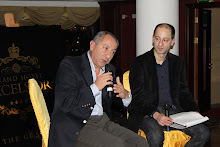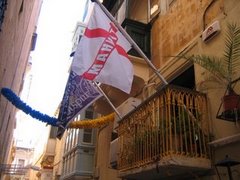

SPORTING CLUB de BRAGA info.
Sporting Clube de Braga is a Portuguese sports club, from the city of Braga, that was founded in 1921. Portuguese club Sporting Braga have been known as Arsenal do Minho -'Minho's Arsenal'- ever since former coach Jose Szabo returned from a match at Highbury in the 1930s and convinced his old team to ditch green in favour of red and white sleeves. (Sporting even renamed their youth team Arsenal do Braga).
Its football team plays at the Braga Municipal Stadium, which was built for Euro 2004. The current manager of Braga is Jorge Costa. They shocked everyone with a 3-2 win over Benfica and 3-2 win against Sporting Lisbon in the last (2005/06) season and a 2-1 win over FC Porto in the 2006\2007 season. The club is now becoming one of Portugal's most successful clubs afer the Big Three and they have been known to eliminate many clubs in major competitions
The new stadium
Estádio Municipal de Braga, entrance
Braga currently play at the Estádio Municipal de Braga stadium. Many a fan were hoping it would bring the team good luck, that it did as Braga have been finishing in the top-half of the table in recent years.
It has one of the most spectacular settings of any stadium in the world, as it is carved out of the Monte Castro hillside that overlooks the city of Braga. The enormous earthmoving process contributed heavily to its €83.1 million cost, more than any other EURO 2004 venue except for the new Estádio da Luz in Lisbon, which has more than twice the capacity of the new Braga stadium. The architect for the project was Eduardo Souto de Moura.
Unlike most major stadiums, Braga Municipal has stands only on the two sides of the field; the two end zones are backed with rock walls left behind from the construction process. The two stands are covered with a canopy-style roof which are connected by multiple steel strings over the pitch, inspired by ancient south American Inca bridges.
The stadium was inaugurated on 30 December 2003 with Braga beating Celta de Vigo 1-0.
Fans of Braga
The fans of SC Braga are known as Arsenalistas due to their never-say-die attitude. Many of Braga fans are known for their crazy antics such as throwing flares in the field to get their players pumped up. However, lately, they have been disappointing. In Braga's round of 32 match against Parma in the Uefa Cup, only 6,500 spectators were present.
Symbols and Europe
The emblem of Sporting Braga is the city of Braga's shield with Mother Mary and baby Jesus. On the top of the Emblem is the Royal Crown of Braga, with the name Sporting Clube da Braga on it. Many fans of SC Braga have said that Mother Mary gives them luck.
Back in the 60's and 70's Braga began to climb up the league ladder and eventually participated in the UEFA Competitions.
Braga's success was thanks to Jesualdo's astute management of his human resources. His pragmatic tactics also paid dividends, skills acquired in a varied career taking in spells with CF Estrela Amadora and the Moroccan Army team FAR Rabat, plus four years with the Portugal Under-21 side.
He is a level-headed character. Musing on the end of Braga's extraordinary run of clean sheets, Jesualdo said: "It was a pity the first goal we conceded this season came from an own goal, as I would have preferred a great goal. But I always also said that, on the day it happened, the priority would be to win the match. It was a record that did not matter much. It was earned by a team which did not concede goals, but without meaning we have a defensive philosophy."
Braga, who owe their Sporting Club tag to the better known Lisboetas, after whom they were named, changed their kits from green-and-white hoops to their Arsenal-style red in 1920 when their then coach Jozef Szab,following a trip to England, ordered the club to adopt new colours to establish their own identity.



No comments:
Post a Comment